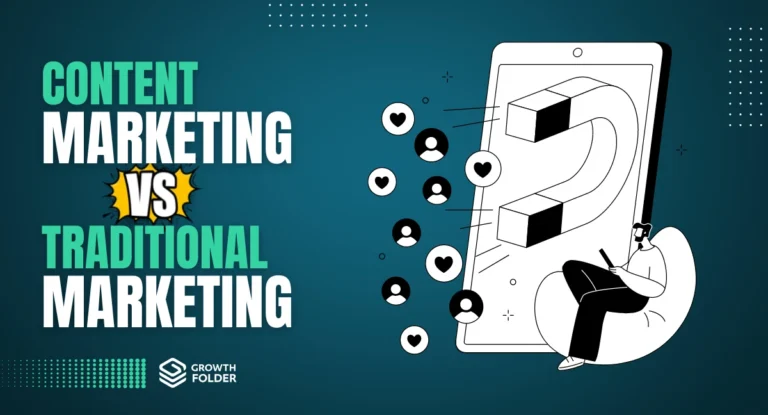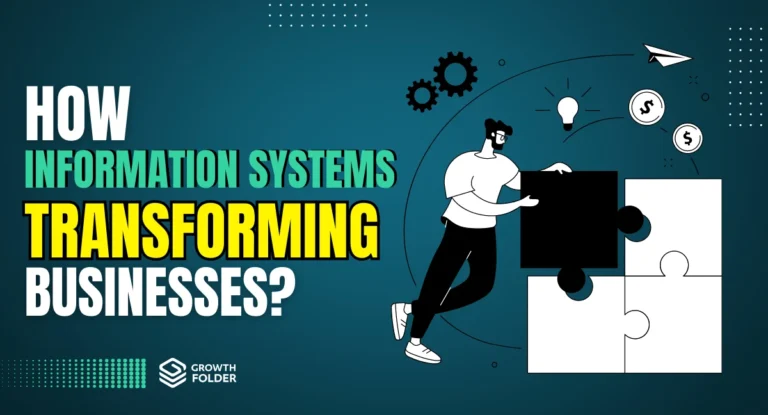
Imagine yourself as a sailor embarking on a journey across uncharted waters.
You know your destination, but you have no idea what lies ahead.

Your ship is your business, and the technology you have onboard is your compass, guiding you through the unknown.
Without it, you would be lost, adrift in a sea of uncertainty.
Just as a sailor relies on his compass to navigate, businesses rely on technology to grow and succeed.
In today’s rapidly evolving business landscape, technology has become an essential tool for businesses looking to stay competitive and achieve their goals.
The integration of technology has brought about new opportunities, allowing businesses to grow and expand in ways never thought possible before.
In this article, we will explore 15 ways of how technology helps business growth, and how you can leverage technology to navigate the rough seas of business and chart a course for success.
13 practical ways of how technology helps business growth
1. Improving Efficiency

Efficiency is ‘THE’ critical factor for any business that aims to grow and thrive in the competitive market.
The integration of technology can help businesses streamline their operations, reduce errors, and save time.
Automation is one such significant way that can be achieved by enabling efficient technology.
By automating repetitive tasks such as data entry, invoicing, and inventory management, businesses can reduce the risk of human error, optimize processes, and free up time for employees to focus on the core tasks.
Additionally, cloud computing is another technology that can help businesses improve efficiency.
It offers a cost-effective way to store data, collaborate, and access applications from anywhere, reducing the need for physical infrastructure and IT support.
2. Enhancing Customer Experience

Customer experience is crucial for businesses looking to grow and succeed in the long run.
With technology, businesses can offer customers a more convenient and personalized experience.
E-commerce is one way that technology can help businesses enhance customer experience. By offering customers the option to shop online, businesses can expand their customer base and provide a more convenient shopping experience.
Mobile apps are another way that businesses can improve the customer experience. They offer a way for businesses to engage with customers, offer personalized services, and improve overall customer satisfaction.
Chatbots are yet another technology that can help businesses enhance customer experience. By providing 24/7 support, responding to inquiries promptly, and reducing customer wait times, chatbots can help businesses improve their customer service and grow their customer base.
3. Enabling Business Intelligence

Data is an essential asset for any business looking to grow and succeed.
Technology can help businesses analyze large volumes of data, gain insights into customer behavior, and make informed decisions.
Business intelligence tools such as data analytics, data mining, and machine learning can help businesses process and analyze data faster and more accurately, enabling them to identify trends, spot opportunities, and make data-driven decisions that can improve business performance.
With technology-enabled business intelligence, businesses can gain a competitive edge and grow faster.
4. Fostering Collaboration

Collaboration is critical for businesses looking to innovate and grow.
With technology, businesses can facilitate communication and collaboration across teams, departments, and geographies.
Video conferencing, instant messaging, and collaboration software are some of the technologies that can help businesses improve collaboration.
By enabling real-time communication and file sharing, businesses can reduce communication barriers, foster creativity, and increase productivity.
Additionally, project management tools can help businesses track progress, assign tasks, and streamline workflows, improving efficiency and enabling better collaboration.
5. Expanding Market Reach

Expanding market reach is essential for businesses looking to grow their customer base and revenue.
With technology, businesses can reach customers beyond their local market and expand into new territories.
Social media is one way that technology can help businesses expand their market reach.
By leveraging social media platforms, businesses can promote their brand, engage with customers, and drive traffic to their websites.
E-commerce platforms such as Amazon and eBay can also help businesses expand their market reach by providing a platform for businesses to sell their products globally.
Additionally, search engine optimization (SEO) can help businesses rank higher in search engine results, improving their visibility and reach.
6. Enhancing Security

Security is a critical concern for any business that uses technology.
With the increase in cyber threats, businesses must protect their data, systems, and networks from malicious attacks.
Technology can help businesses enhance their security and protect against cyber threats. Anti-virus software, firewalls, and encryption are some of the technologies that can help businesses enhance their security.
By implementing security measures, businesses can safeguard their data and maintain the trust of their customers.
Additionally, security technologies such as biometric authentication and multi-factor authentication can help businesses protect against unauthorized access and prevent data breaches.
7. Offering Flexibility

Technology can offer businesses flexibility and agility, enabling them to adapt to changing market conditions and customer needs.
Cloud computing is one technology that can offer businesses flexibility.
By offering a pay-as-you-go model, businesses can scale their infrastructure up or down as needed, without having to invest in costly physical infrastructure.
Additionally, remote work technologies such as virtual private networks (VPNs) and collaboration software can help businesses offer flexibility to their employees.
By enabling employees to work from anywhere, businesses can attract and retain top talent, reduce overhead costs, and improve productivity.
8. Improving Decision-Making

Technology can help businesses make better-informed decisions.
Business intelligence tools can provide businesses with real-time insights into customer behavior, market trends, and sales data, enabling them to make informed decisions that can improve business performance.
Additionally, predictive analytics can help businesses forecast trends and identify potential risks, allowing them to take proactive measures to mitigate them.
By making data-driven decisions, businesses can optimize their operations, reduce costs, and grow faster.
9. Enhancing Innovation

Innovation is crucial for every business looking to grow and compete in the market.
With technology, businesses can foster creativity, experiment with new ideas, and bring innovative products and services to market.
Collaboration software and project management tools can help businesses facilitate innovation by enabling teams to work together, share ideas, and experiment with new approaches.
Additionally, emerging technologies such as artificial intelligence (AI), blockchain, and virtual reality (VR) can help businesses bring new products and services to market, offering unique and innovative solutions that can differentiate them from competitors.
10. Enhanced Marketing

With technology, businesses can enhance their marketing efforts, reach more customers, and generate more revenue.
Social media marketing is one way that technology can help businesses enhance their marketing efforts.
By leveraging social media platforms, businesses can reach a wider audience, engage with customers, and promote their brands.
Email marketing is another way that technology can help businesses enhance their marketing efforts.
By using email marketing tools, businesses can send targeted and personalized emails to customers, improving engagement and conversion rates.
Additionally, marketing automation tools can help businesses streamline their marketing processes, reducing manual effort and improving efficiency.
11. Improving Customer Feedback

Feedback is essential for businesses looking to improve their products and services and grow their customer base.
With technology, businesses can improve the process of collecting and analyzing customer feedback.
Online surveys and feedback forms are one way that technology can help businesses improve their customer feedback process.
By collecting feedback electronically, businesses can gather feedback from a larger audience and analyze it more efficiently.
Additionally, social media monitoring tools can help businesses track customer sentiment and respond to feedback promptly, improving customer satisfaction and loyalty.
12. Reducing Costs

With technology, businesses can reduce costs, improve efficiency, and increase profitability.
Automation is one technology that can help businesses reduce costs.
By automating repetitive tasks, businesses can reduce the need for manual labor, reducing labor costs and improving efficiency.
Additionally, cloud computing can help businesses reduce costs by eliminating the need for physical infrastructure, reducing overhead costs.
Outsourcing IT services is another way that technology can help businesses reduce costs.
By outsourcing IT services to third-party providers, businesses can reduce their IT staffing costs and improve the quality of their IT services.
13. Providing Competitive Advantage

Technology can provide businesses with a competitive advantage, enabling them to differentiate themselves from competitors and gain a larger market share.
Emerging technologies such as AI and machine learning can help businesses gain insights into customer behavior and preferences, allowing them to provide more personalized and relevant products and services.
Additionally, technology can help businesses improve their operational efficiency, reduce costs, and offer innovative solutions, allowing them to stay ahead of competitors.
Risks of Implementing New Technology

While implementing new technology can bring a range of benefits to businesses, it is important to acknowledge the potential risks that come with it.
Here are four key risks that businesses should be aware of when implementing new technology:
Unrealistic Expectations:
Simply put, it means you expect something from the new software, but it doesn’t deliver.
Before absorbing any new software, we will have some common expectations from it, such as:
- It should lower the cost of one or more business processes.
- It should be easy to use and deploy.
- It should streamline operations through automation.
- It should seamlessly integrate with the existing workflow.
Although it’s perfectly alright to have some expectations with any new change, it may happen sometimes that the new technology is lagging the already established system down.
To avoid such tragedies, vendor communication is crucial. Before the final rollout, ask every question relevant to your industry and go for the demo version to feel exactly what is going to be delivered to you.
Implementation Costs:
One of the main risks of implementing new technology is the associated costs.
This can include not only the cost of purchasing the technology itself but also the cost of training employees and integrating the new technology into your existing systems.
It’s important to carefully consider the financial implications of implementing new technology and ensure that the potential benefits outweigh the costs.
Disruption To Workflows:
If the new technology requires a significant change to the way your business operates, it can take time for employees to adjust and this could cause disruptions to productivity.
To minimize this risk, it’s important to provide adequate training and support to employees and ensure that the new technology is integrated into your workflows in a way that is as seamless as possible.
Security Risks:
Finally, implementing new technology can also pose security risks to your business.
This can include the risk of data breaches, cyber-attacks, and system failures.
To mitigate this risk, it’s important to prioritize data security and ensure that the new technology is properly secured and monitored to prevent any potential threats.
What are the risk of adopting a new technology too early?

Adopting a new technology too early can be just as risky as not adopting it at all. Here are four key risks of adopting a new technology too early:
Uncertainty About Its Viability:
New technologies are often untested and unproven, and adopting them too early can lead to unforeseen problems.
This can include technical glitches, compatibility issues, and unexpected costs.
Before adopting a new technology, it’s important to ensure that it has been thoroughly tested and that there is evidence to suggest that it will be viable in the long term.
Limited Support:
Early adopters of new technologies may find that there is limited support available, as vendors may not have had the opportunity to build up a network of support staff or develop adequate documentation.
This can make it difficult to troubleshoot problems and can increase the likelihood of downtime.
The cost of implementation:
Adopting a new technology too early can be costly, as vendors may charge a premium for early access or for developing custom solutions.
In addition, the technology may not be fully developed, requiring significant investment in development and customization.
Reduced Efficiency:
Early adoption of new technology may lead to reduced efficiency and productivity, as employees may not be fully trained on the new system or may struggle to integrate it into their existing workflows.
This can lead to disruptions and can impact the overall success of the business.
By waiting until a new technology has been thoroughly tested and its viability established, businesses can avoid these risks and ensure that their adoption of new technology is successful and beneficial in the long term.
What Can You Do Right Now?

Technology evolves rapidly. It moves so fast that the moment you decide to adopt a particular software in your business, it changes or gets upgraded the other day itself.
To determine what technology upgrade your business needs and how to initiate working on them, here are a few steps you can take on an immediate basis:
Conduct a technology audit:
Start by conducting a comprehensive technology audit of your business operations to identify areas where technology can be implemented or improved.
This will help you identify the gaps in your current technology stack and prioritize areas for improvement.
Stay up-to-date on industry trends:
Keep yourself informed about the latest industry trends and advancements in technology that can be applied to your business.
Attend conferences, read industry publications, and network with peers to stay up-to-date.
Consult with technology experts:
Seek out the advice of technology experts who can provide valuable insights into what technology solutions are best suited to your business needs.
These experts can help you understand the benefits and drawbacks of various options and provide guidance on implementation.
Develop a technology strategy:
Based on the insights you’ve gathered, develop a technology strategy that outlines the technology solutions you will implement, the timeline for implementation, and the resources required.
This strategy should be aligned with your overall business goals and should take into account factors such as budget and available resources.
take action:
With your technology strategy in place, take action to implement the identified technology solutions.
This may include investing in new software, hardware, or cloud-based solutions, training employees, and developing new processes.
FAQs
Q1. What is the impact of technology on business?
Technology has revolutionized the way businesses operate. It has made businesses more efficient, productive, and innovative, while also opening up new markets and revenue streams.
By enabling businesses to stay competitive and respond quickly to changing market conditions and customer demands, technology has had a significant impact on business operations.
Q2. How has technology helped small business grow?
Technology has leveled the playing field for small businesses, enabling them to compete with larger corporations.
For example, e-commerce platforms and social media have made it easier for small businesses to sell their products and services online, without the need for a physical storefront.
Additionally, cloud-based software and automation tools have streamlined business operations, reducing costs and increasing productivity.
Overall, technology has empowered small businesses to grow and thrive in ways that were previously unimaginable.
Q3. What is the Importance of technology in business communication?
Technology has revolutionized communication within businesses. Digital communication channels like email, instant messaging, and video conferencing enable employees to connect and collaborate from anywhere, improving productivity and reducing response times.
Digital platforms such as social media, CRM software, and marketing automation tools provide new channels for businesses to engage with customers and partners in real-time, enhancing relationships and providing valuable insights.
Conclusion
In conclusion, it is clear that technology plays a critical role in the growth and success of businesses.
The 15 ways we have explored in this article are just the tip of the iceberg when it comes to the ways technology can help businesses grow and succeed.
From streamlining operations and improving productivity to enhancing communication and collaboration, technology offers a wealth of benefits that can help businesses achieve their goals and stay competitive in today’s fast-paced business world.
By embracing innovation and investing in the latest technologies, businesses can position themselves for success and grow faster than ever before.
So, if you want to take your business (no matter if you have a small business or a big corporation) to the next level and achieve long-term success, it is essential to leverage technology and embrace the opportunities it offers.
Remember, the future belongs to those who innovate, so start exploring the latest technologies today and give your business the competitive edge it needs to thrive.






